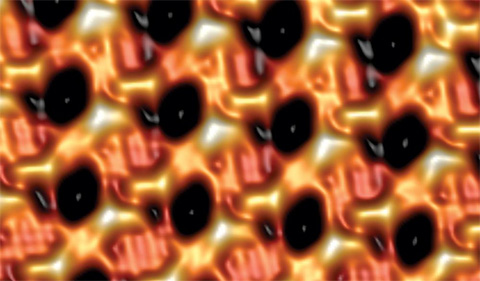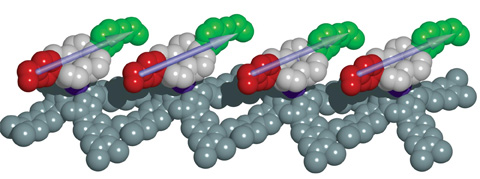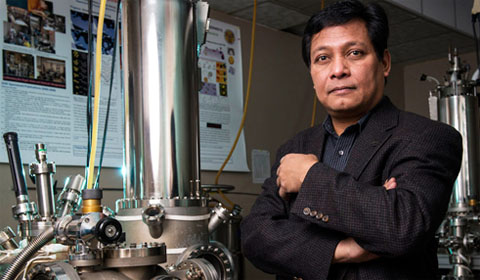
Scanning tunneling microscope image showing a parallel arrangement of dipolar motor assembly. Image credit: Saw-Wai Hla
By Amanda Biederman
NQPI editorial intern
Ohio University Professor of Physics & Astronomy and Nanoscale & Quantum Phenomena Institute member Saw-Wai Hla recently demonstrated simultaneous operation of hundreds of synchronized molecular rotors that, through dipole interactions based on carefully tailored positive and negative forces at different points within the system, may be used in the future to transmit information at the nanoscale.
Hla’s group published their findings, in collaboration with researchers from the the Centers for Materials Elaboration and Structural Studies (CEMES/CNRS) in Toulouse, France, in Nature Nanotechnology last May.
In 2013, the group developed a molecule that could function as a nanoscale automatic machine, i.e. a motor. The machine consists of a molecular tripodal stator and a five-arm rotor, which are connected by a ball bearing ruthenium atom. The stator is adhered to a gold surface via three thioether groups, and four rotor arms contain ferrocene groups at the ends. This single unit can rotate in a clockwise or counterclockwise manner when an electron current is applied to different parts of the motor.

This illustration shows parallel motors with dipolar rotator arms indicated by arrows. The green and red units represent negative and positive charges. Image credit: Saw-Wai Hla
Next, the group used this principle to develop a molecular machine network made up of single motor units. This time, the stator is four-legged and the rotor is composed of a porphyrin ring complex, supported by a ball-bearing europium atom.
When hundreds of these molecular units are brought together on a copper crystal surface, they form a hexagonal structure. When one volt of electrical energy is applied to the units, 500 of the motors rotate in a synchronized manner. Hla explained that the units move together, like soldiers, to minimize repulsion due to dipole interactions, thus maintaining a low energy conformation.
“We’ve developed a way for molecular motors to talk to one another, in a way,” Hla said. “They know what their neighbor is doing…. It’s like a domino effect; you turn one, and the rest will follow.”
Hla said the technology could be potentially used to transmit information at the nanoscale, and he suggested the system could be used to create electro-mechanical and electronic devices. Additionally, he said, his group’s work has helped to increase the scientific community’s fundamental understanding of how molecular motors function overall.
- Read more in OHIO Research News: “Scientists develop synchronized molecular motors.”
- “Simultaneous and coordinated rotational switching of all molecular rotors in a network” was published in Nature Nanotechnology.



















Comments